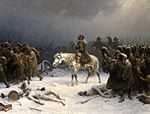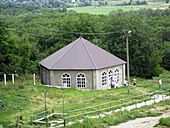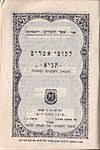Shneur Zalman of Liadi facts for kids
Quick facts for kids Shneur Zalman of Liadi |
|
|---|---|
| Alter Rebbe / Baal HaTanya | |
 |
|
| Born | 15 September 1745 [OS: 4 September 1745] Liozna, Polish–Lithuanian Commonwealth |
| Died | 27 December 1812 (aged 67) [OS: 15 December 1812] Pena, Kursk Governorate Russian Empire |
| Buried | Hadiach |
| Dynasty | Chabad |
| Predecessor | Dovber of Mezeritch |
| Successor | Dovber Schneuri |
| Father | Boruch |
| Mother | Rivkah |
Shneur Zalman of Liadi (Hebrew: שניאור זלמן מליאדי, 1745–1812) was a very important Orthodox rabbi. He founded and became the first leader, or Rebbe, of the Chabad movement. Chabad is a special branch of Hasidic Judaism. At the time, it was based in a town called Liadi in the Russian Empire.
Shneur Zalman wrote many books. His most famous works are Shulchan Aruch HaRav and Tanya. He also put together a prayer book called Siddur Torah Or. People often call him "Alter Rebbe," which means "Old Rabbi" in Yiddish. He is also known as "Baal HaTanya," meaning "Master of the Tanya."
Contents
Biography
Early Life and Learning
Shneur Zalman was born in 1745 in Liozna, which was then part of the Polish-Lithuanian Commonwealth. Today, this area is in Belarus. His father, Baruch, was a descendant of the famous Rabbi Judah Loew ben Bezalel.
From a young age, Shneur Zalman showed amazing talent. By the time he was eight years old, he had written a detailed explanation of the Torah. This commentary was based on the works of other great scholars.
He studied in Lubavitch until he was 12. His teacher was so impressed that he told Shneur Zalman's father the boy no longer needed a teacher. At 12, he gave a complex speech about Jewish law. The townspeople then gave him the title "Rav," meaning "Rabbi."
At 15, he married Sterna Segal. Her father was a wealthy man, which allowed Shneur Zalman to focus completely on his studies. During these years, he also learned about mathematics, geometry, and astronomy. He became very skilled in Kabbalah, which is a mystical part of Jewish tradition. In 1764, he became a student of Dov Ber of Mezeritch, a very important Hasidic leader. In 1767, at age 22, he became a maggid (preacher) in Liozna.
Facing Opposition
As the Hasidic movement grew, some Jewish communities opposed it. These opponents were called "Misnagdim." They disagreed about things like how butchers prepared meat and how prayers were said.
Shneur Zalman tried to talk with the leader of Lithuanian Jewry, the Vilna Gaon. The Gaon was a very respected scholar and a strong opponent of Hasidism. However, the Gaon refused to meet with Shneur Zalman.
Family and Successors
Shneur Zalman had three sons: Dovber Schneuri, Chaim Avraham, and Moshe. His daughters were named Freida, Devorah Leah, and Rochel.
Dovber Schneuri Takes Over
Dovber Schneuri became the next Rebbe of the Chabad movement after his father passed away. Shneur Zalman died at age 39 in the city of Kremenchug.
After his father's death, Dovber Schneuri moved the movement to the town of Lubavichi. The Chabad movement then became known by this town's name. Some of Shneur Zalman's followers disagreed with Dovber's leadership. They followed another student, Aharon HaLevi of Strashelye. This caused Chabad to split into two groups.
Dovber Schneuri started a Yeshivah (a Jewish school) in Lubavitch. It attracted many talented young scholars. His son-in-law, Menachem Mendel of Lubavitch, led this Yeshivah and later became the next Rebbe.
The Strashelye Group
When Shneur Zalman died, some of his followers chose to follow Aharon HaLevi of Strashelye. He had been a close student of Shneur Zalman for over 30 years.
Aharon HaLevi believed that emotions were very important in serving God, especially during prayer. Dovber Schneuri agreed that emotions were important. However, he taught that true emotion in prayer comes from deep thought and understanding. He believed this understanding would lead to "bittul," which means losing your sense of self before God.
Moshe Schneersohn
Moshe Schneersohn was Shneur Zalman's youngest son.
Leading in Lithuania
After Dovber's death, Shneur Zalman became a key leader of Hasidism in Lithuania. This region was a center for the "misnagdim" (opponents of Hasidism). Shneur Zalman faced a lot of opposition there.
In 1774, he tried again to meet the Vilna Gaon in Vilna. The Gaon had issued a ban against the Hasidim. But the Gaon still refused to see them.
Despite this, Shneur Zalman successfully created many Hasidic centers. He also supported the Tsar against Napoleon's advance on Russia. He encouraged his followers to join the Tsar's army. He also helped raise money for Jewish communities in the Land of Israel.
Chabad Philosophy
Shneur Zalman wanted to explain Kabbalah and Hasidism in a way that made sense to people. In his main book, Tanya, he described his approach as "mind ruling over the heart."
He named his philosophy "Chabad." This is a Hebrew acronym for three intellectual qualities:
- Chochma (wisdom)
- Bina (understanding)
- Da'at (knowledge)
Shneur Zalman taught that people are not just passive. They are dynamic beings who must work to develop their talents. They should try to improve themselves. Chabad focuses on understanding God through deep thought. This is different from other forms of Hasidism, which often focus more on emotions.
Shneur Zalman was born on the 18th of Elul, the same Hebrew birthday as the Baal Shem Tov. The Baal Shem Tov founded the entire Hasidic movement. Chabad tradition sees them as two great lights. The Baal Shem Tov revealed endless faith. Shneur Zalman helped people understand this faith with their minds.
Against Napoleon
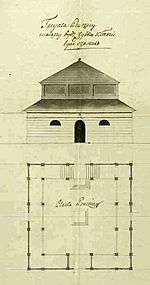
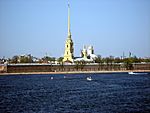
During the French invasion of Russia, many Polish Hasidic leaders supported Napoleon. But Shneur Zalman strongly supported the Tsar.
He believed that if Napoleon won, Jews might become wealthy. However, he feared their connection to God would weaken. If the Tsar won, there might be poverty. But he believed the Jewish people's hearts would stay close to God. He even wrote a letter about this, asking his friend to burn it.
Some people think Shneur Zalman opposed Napoleon because Napoleon tried to make Jews think he was a messiah. Napoleon opened up Jewish ghettos and tried to recruit Jews to his army. Shneur Zalman worried that Jews might be tricked by Napoleon's false promises.
Arrests and Release
In 1797, after the Vilna Gaon died, some leaders accused the Hasidim of disloyal actions. They claimed Shneur Zalman supported the Ottoman Empire. This was because he encouraged sending money to Jews living in Palestine, which was under Ottoman rule.
In 1798, he was arrested for suspected treason. He was taken to St. Petersburg and held in the Peter and Paul Fortress for 53 days. He was questioned by a secret group. Finally, Paul I of Russia ordered his release.
The day of his release, the 19th of Kislev on the Hebrew calendar, is celebrated every year by Chabad Hasidim. They have a festive meal and promise to study the entire Talmud. This is called "Chalukat HaShas."
In Chabad tradition, his imprisonment meant that his new mystical teachings were being revealed too widely. Jewish mysticism was traditionally kept secret. A story tells of a time when a student of Dov Ber of Mezeritch saw Hasidic writings blowing in the wind. He worried that these holy teachings were being disrespected. Shneur Zalman replied with a famous story:
A king had a sick son, and no doctor could cure him. A wise person said the only cure was to take the most precious jewel from the king's crown. This jewel had to be ground up and given to the son. The king was sad to lose his jewel but agreed because his son's life was more important. The jewel was ground, and the solution was given to the son. Most of it fell to the ground, but a few drops cured the son.
Shneur Zalman explained that the king is God, and the son is the Jewish people. At that time, the Jewish people were struggling. The only cure was to spread the inner, divine teachings of Hasidic thought. Even if some of it was "desecrated" by being spread widely, it was worth it to heal the people. The student understood this wisdom.
Chabad followers believe that Shneur Zalman's later imprisonment meant a new, even stronger heavenly accusation. This was because he was explaining Hasidic thought in a new, deeper way. His release by the Tsar meant that Heaven agreed to spread Hasidic thought even more widely. In prison, Shneur Zalman was visited by the spirits of the Baal Shem Tov and the Maggid of Mezeritch. They told him to continue his work with even more dedication. So, the 19th of Kislev is called the "New Year of Hasidut."
In 1800, Shneur Zalman was arrested again and taken to St. Petersburg. His son Moshe went with him as an interpreter. He was released after a few weeks. When Tsar Alexander I came to power, Shneur Zalman was given full freedom to teach his religious ideas.
Life in Liadi
After his release, Shneur Zalman moved to Liadi, in Imperial Russia. He lived there for 12 years. His movement grew greatly in Liadi.
In 1812, he had to flee from the French Invasion. He died on the way in a small village called Pena, near Kursk Oblast. He is buried in Hadiach.
Chabad's Later History
Dovber Schneuri moved the Chabad movement to the town of Lubavitch. Another student of Shneur Zalman, Aharon HaLevi Horowitz, started a different Chabad school in Strashelye. However, this group did not last after his death.
In 1940, the Chabad-Lubavitch movement moved its main center to Brooklyn, New York in the United States. Under the leadership of Menachem Mendel Schneerson, Chabad has grown worldwide. They have branches everywhere, led by rabbis trained in Lubavitch.
Many of Shneur Zalman's descendants have surnames like Shneur, Shneuri, Schneerson, and Zalman.
His Writings
Shneur Zalman was a very productive writer. He wrote books on both mysticism and Jewish law. His Yiddish name "Shneur" means "Two Lights" in Hebrew. This refers to his mastery of both the outer parts of Jewish study (like Talmud) and the inner parts (like Jewish mysticism). His writings are the foundation of Chabad philosophy. He could explain complex ideas clearly, making his books popular with scholars.
The Tanya
He is most famous for his book Likkutei Amarim, better known as the Tanya. It was first published around 1797. The original 1797 version was lost in a fire. The version we have today is from 1814. Because of this book's popularity, Hasidic Jews often call him the Baal HaTanya. The Tanya explores Jewish spirituality and psychology using ideas from Kabbalah. It discusses topics like the Oneness of God, Tzimtzum (God's contraction), and Sefirot (divine qualities).
Shulchan Aruch HaRav
Shneur Zalman is also well known for the Shulchan Aruch HaRav. This book is a collection of important Jewish laws and customs. He wrote it when he was only 21 years old. His teacher, Dov Ber of Mezeritch, asked him to create a new version of the classic Shulkhan Arukh for the Hasidic movement.
The Shulchan Aruch HaRav explains Jewish law and the reasons behind it. It also includes common Hasidic customs. Other Hasidic groups consider this book important. It is even cited in non-Hasidic books like the Mishnah Berurah.
The Siddur
He also put together the first Chabad siddur (prayer book). It was based on the Ari Siddur by the famous kabbalist Isaac Luria. Shneur Zalman changed it for general use and fixed mistakes in the text. Today's Siddur Tehillat HaShem is a later printing of his Siddur.
His Music
Shneur Zalman composed many Hasidic melodies, called niggunim. Some of these tunes go with prayers. Others are sung to verses from the Bible or are just melodies without words. These tunes are meant to bring joy, spiritual excitement, or encourage teshuvah (returning to God). One special melody, called The Alter Rebbe's Niggun, is used by Chabad Hasidim for special occasions, like leading a bride and groom to their wedding canopy.
Other Works
Shneur Zalman's other writings include:
- Torah Or and Likutei Torah: These books explain the weekly Torah portions and other biblical texts. They are based on his Hasidic speeches.
- Sefer HaMa'amarim: Collections of his Hasidic discourses.
- Hilchot Talmud Torah: A book about the study of Torah.
- Sefer She’elot Uteshuvot: A collection of his Responsa (answers to Jewish law questions).
- Siddur Im Dach: A prayer book that includes Hasidic discourses.
Images for kids
See also
 In Spanish: Schneur Zalman de Liadí para niños
In Spanish: Schneur Zalman de Liadí para niños


